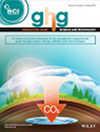Xiangbo Zou, Kai Xiong, Wei Zhao, Yafang Li, Dequn Ma, Chuangting Chen, Zhenwei Yi, Tao Wang
求助PDF
{"title":"Cementless Aggregate From Industrial Solid Wastes: Optimization Preparation and Environmental Impact Assessment","authors":"Xiangbo Zou, Kai Xiong, Wei Zhao, Yafang Li, Dequn Ma, Chuangting Chen, Zhenwei Yi, Tao Wang","doi":"10.1002/ghg.2336","DOIUrl":null,"url":null,"abstract":"<div>\n \n <p>To address the issues of high density and low strength in traditional non-fired lightweight aggregates, using CO<sub>2</sub> mineralization curing can effectively enhance product performance and synergistically utilize industrial solid waste and CO<sub>2</sub>. CO<sub>2</sub> mineralization curing significantly improves the cylindrical compressive strength of lightweight aggregates (6.8 MPa), reduces the water absorption rate (6.83%), and achieves a suitable bulk density (896 kg/m<sup>3</sup>). By analyzing the carbonation rate of different particle sizes through gas–solid reaction kinetics, it was found that the rate curve of mineralization curing for lightweight aggregate samples better fits the three-dimensional diffusion model, with smaller particles exhibiting a higher carbonation rate. Microscopic characterization analysis revealed that the primary mineralization product is calcium carbonate, which is present in the form of calcite. Higher curing temperatures and prolonged durations may result in decalcification within the lightweight aggregates. Moreover, the calcium carbonate particles produced during the carbonation process can cause expansion of the internal structure of the lightweight aggregates, leading to a decline in the mechanical properties of the product. The life cycle carbon emissions for each ton of steam-cured lightweight aggregate are 105.821 kg, whereas the life cycle carbon emissions for CO<sub>2</sub> mineralized lightweight aggregates are only −1.879 kg, making this method beneficial for clean production and solving significant problems in actual production. © 2025 Society of Chemical Industry and John Wiley & Sons, Ltd.</p>\n </div>","PeriodicalId":12796,"journal":{"name":"Greenhouse Gases: Science and Technology","volume":"15 3","pages":"305-318"},"PeriodicalIF":2.8000,"publicationDate":"2025-04-03","publicationTypes":"Journal Article","fieldsOfStudy":null,"isOpenAccess":false,"openAccessPdf":"","citationCount":"0","resultStr":null,"platform":"Semanticscholar","paperid":null,"PeriodicalName":"Greenhouse Gases: Science and Technology","FirstCategoryId":"93","ListUrlMain":"https://scijournals.onlinelibrary.wiley.com/doi/10.1002/ghg.2336","RegionNum":4,"RegionCategory":"环境科学与生态学","ArticlePicture":[],"TitleCN":null,"AbstractTextCN":null,"PMCID":null,"EPubDate":"","PubModel":"","JCR":"Q3","JCRName":"ENERGY & FUELS","Score":null,"Total":0}
引用次数: 0
引用
批量引用
Abstract
To address the issues of high density and low strength in traditional non-fired lightweight aggregates, using CO2 mineralization curing can effectively enhance product performance and synergistically utilize industrial solid waste and CO2 . CO2 mineralization curing significantly improves the cylindrical compressive strength of lightweight aggregates (6.8 MPa), reduces the water absorption rate (6.83%), and achieves a suitable bulk density (896 kg/m3 ). By analyzing the carbonation rate of different particle sizes through gas–solid reaction kinetics, it was found that the rate curve of mineralization curing for lightweight aggregate samples better fits the three-dimensional diffusion model, with smaller particles exhibiting a higher carbonation rate. Microscopic characterization analysis revealed that the primary mineralization product is calcium carbonate, which is present in the form of calcite. Higher curing temperatures and prolonged durations may result in decalcification within the lightweight aggregates. Moreover, the calcium carbonate particles produced during the carbonation process can cause expansion of the internal structure of the lightweight aggregates, leading to a decline in the mechanical properties of the product. The life cycle carbon emissions for each ton of steam-cured lightweight aggregate are 105.821 kg, whereas the life cycle carbon emissions for CO2 mineralized lightweight aggregates are only −1.879 kg, making this method beneficial for clean production and solving significant problems in actual production. © 2025 Society of Chemical Industry and John Wiley & Sons, Ltd.
工业固体废弃物无水泥骨料:优化制备及环境影响评价
针对传统非烧制轻骨料密度大、强度低的问题,采用CO2矿化固化可以有效提高产品性能,实现工业固体废弃物与CO2的协同利用。CO2矿化养护显著提高了轻质集料的圆柱抗压强度(6.8 MPa),降低了吸水率(6.83%),获得了合适的容重(896 kg/m3)。通过气固反应动力学分析不同粒径颗粒的碳化速率,发现轻骨料矿化固化速率曲线更符合三维扩散模型,颗粒越小,碳化速率越高。显微表征分析表明,原生矿化产物为碳酸钙,以方解石形式存在。较高的养护温度和较长的养护时间可能导致轻骨料中的脱钙。此外,碳化过程中产生的碳酸钙颗粒会使轻质集料内部结构膨胀,导致产品力学性能下降。每吨蒸汽固化轻骨料的全生命周期碳排放量为105.821 kg,而CO2矿化轻骨料的全生命周期碳排放量仅为- 1.879 kg,有利于清洁生产,解决了实际生产中的重大问题。©2025化学工业协会和John Wiley &;儿子,有限公司
本文章由计算机程序翻译,如有差异,请以英文原文为准。





 求助内容:
求助内容: 应助结果提醒方式:
应助结果提醒方式:


